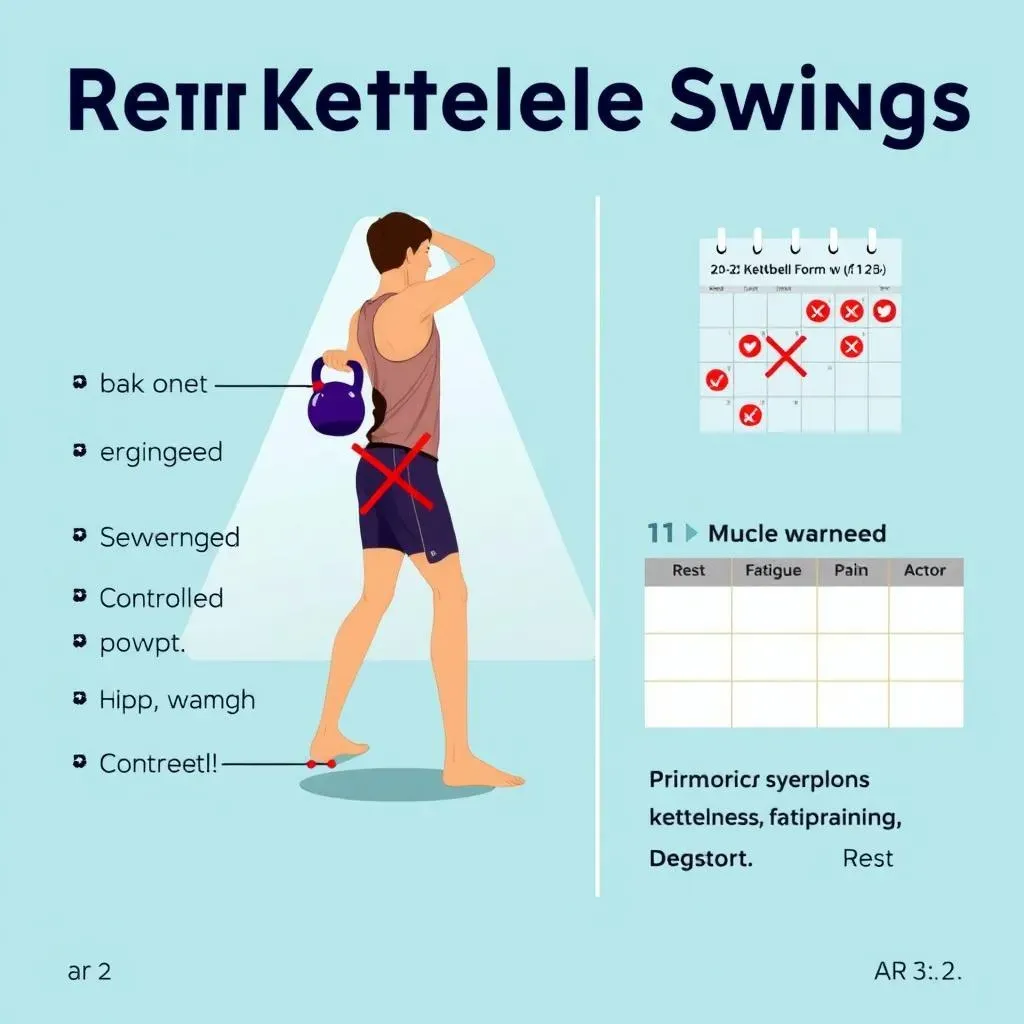Table of Contents
Ready to unlock a stronger, more stable core? If you're just starting your fitness journey, or you're looking for a new way to challenge your midsection, a kettlebell core workout beginner routine might be exactly what you need. Kettlebells aren't just for building biceps or blasting fat; they're incredible tools for sculpting a resilient core that enhances everything from your posture to your athletic performance. This article is your friendly guide to understanding why kettlebells are so effective for core work, what essential exercises you should master as a beginner, and how to structure a simple yet powerful workout. We'll also cover common mistakes to avoid, ensuring you stay safe and get the most out of every swing, lift, and twist. Forget endless crunches – it's time to grab a kettlebell and discover how to build a core that's as functional as it is strong. Get ready to feel the burn and see real results!
Why Kettlebells Are Awesome for Your Core

Why Kettlebells Are Awesome for Your Core
More Than Just Abs: The Full-Body Core Connection
Let's be real: when most people think "core," they picture six-pack abs. And while kettlebells can definitely help you chisel those, they offer so much more. Kettlebell training is all about functional fitness, meaning it strengthens your core in ways that directly translate to real-life movements. Think about it: every time you swing, lift, or stabilize a kettlebell, you're engaging not just your abs, but also your obliques, lower back, glutes, and even your shoulders. It's a total-body party, and your core is the VIP.
The beauty of kettlebells lies in their offset center of gravity. Unlike dumbbells, where the weight is evenly distributed, kettlebells force your core to constantly work to maintain balance and control. This creates a unique challenge that traditional ab exercises simply can't replicate. You're not just contracting muscles; you're building stability, control, and muscular endurance – all essential for a strong and resilient core.
Stability, Power, and Real-World Strength
so we've established that kettlebells work your entire core, not just your abs. But what does that actually mean for you? A stronger core translates to improved posture, reduced risk of injury, and increased power in everything you do. Whether you're lifting groceries, playing sports, or just sitting at your desk, a solid core provides the foundation for efficient and pain-free movement.
Kettlebell exercises train your core to act as a stabilizer, preventing unwanted movement and protecting your spine. This is crucial for preventing lower back pain, a common complaint among adults. Furthermore, a strong core allows you to generate more power from your hips and legs, making you faster, stronger, and more athletic overall. It's like having a secret weapon that enhances every aspect of your physical life.
Essential Kettlebell Exercises for Core Strength: A Beginner's Guide

Essential Kettlebell Exercises for Core Strength: A Beginner's Guide
Mastering the Basics: Kettlebell Fundamentals
Alright, let's dive into the good stuff! Before you start swinging kettlebells like a pro, it's crucial to nail down some fundamental movements. These aren't just warm-ups; they're the building blocks for everything else you'll do. Think of them as learning your ABCs before writing a novel. We're talking about exercises like the kettlebell deadlift, which teaches you how to hinge at the hips and engage your core to protect your lower back. Then there's the kettlebell swing, the king of all kettlebell exercises, which builds explosive power and strengthens your entire posterior chain (that's everything from your glutes to your back muscles). And don't forget the goblet squat, a fantastic way to improve your squat form and fire up your core at the same time.
Focus on proper form above all else. It's better to start with a lighter weight and master the technique than to go heavy and risk injury. Watch videos, read articles, and even consider working with a qualified kettlebell instructor to ensure you're doing things right. Trust me, your body will thank you in the long run. Once you've got these basics down, you'll be ready to move on to more advanced core-specific exercises.
Here's a quick checklist to keep in mind:
- Kettlebell Deadlift: Hinge at the hips, keep your back straight, and engage your core.
- Kettlebell Swing: Generate power from your hips, not your arms. Keep your core tight throughout the movement.
- Goblet Squat: Hold the kettlebell close to your chest and squat down as low as you can while maintaining good form.
Top Kettlebell Core Exercises for Beginners
Now for the main event: the best kettlebell exercises to target your core. We're not just talking about crunches here; these moves engage your core in a functional, three-dimensional way. First up is the kettlebell halo, a deceptively challenging exercise that improves shoulder mobility and strengthens your obliques. Then there's the Russian twist, a classic core exercise that gets a serious upgrade with a kettlebell. And let's not forget the farmer's carry, which might seem simple but is incredibly effective for building core stability and grip strength. Seriously, try walking around with heavy kettlebells in each hand and tell me your core isn't working!
Remember, consistency is key. Aim to incorporate these exercises into your routine 2-3 times per week, and gradually increase the weight or reps as you get stronger. Don't be afraid to experiment and find what works best for you. And most importantly, listen to your body. If you feel any pain, stop and adjust your form or weight. With a little patience and dedication, you'll be well on your way to a stronger, more resilient core.
Here's a breakdown of those core-crushing exercises:
Exercise | Muscles Targeted | How to Do It |
|---|---|---|
Kettlebell Halo | Obliques, Shoulders | Circle the kettlebell around your head, keeping your core engaged. |
Russian Twist | Obliques, Abs | Sit with your knees bent and feet off the ground. Twist your torso from side to side, tapping the kettlebell on the floor. |
Farmer's Carry | Core Stability, Grip Strength | Hold a kettlebell in each hand and walk for a set distance or time. |
Putting It All Together: A Sample Kettlebell Core Workout for Beginners

Putting It All Together: A Sample Kettlebell Core Workout for Beginners
Warm-Up: Get Your Body Ready
Before you jump into the main workout, it's essential to warm up your muscles and get your blood flowing. A dynamic warm-up will prepare your body for the exercises ahead and reduce your risk of injury. Start with some light cardio, such as jogging in place or jumping jacks, for a few minutes. Then, move on to dynamic stretches that target your core and surrounding muscles. Think arm circles, leg swings, and torso twists. The goal is to increase your range of motion and activate the muscles you'll be using during the workout.
Don't skip the warm-up! It's tempting to jump straight into the exercises, but a proper warm-up is crucial for preventing injuries and maximizing your performance. Aim for at least 5-10 minutes of dynamic stretching before each workout. Your body will thank you for it.
- Jumping jacks (1 minute)
- Arm circles (10 forward, 10 backward)
- Leg swings (10 each leg, forward and sideways)
- Torso twists (10 each side)
The Workout: Core-Strengthening Kettlebell Circuit
Alright, now for the main event: the kettlebell core workout! This circuit is designed to target all the major muscles in your core, including your abs, obliques, and lower back. Perform each exercise for the recommended number of reps or time, then rest for a short period before moving on to the next exercise. Once you've completed all the exercises in the circuit, rest for a longer period and repeat the circuit 2-3 times. Remember to focus on proper form throughout the workout, and don't be afraid to modify the exercises or weight as needed.
This workout is just a starting point. As you get stronger, you can gradually increase the weight, reps, or sets. You can also add new exercises to keep things challenging and prevent plateaus. The key is to listen to your body and make adjustments as needed. And most importantly, have fun! Kettlebell training should be enjoyable, so find a routine that you look forward to doing.
Exercise | Reps/Time | Rest |
|---|---|---|
Kettlebell Halo | 8-12 reps per side | 30 seconds |
Russian Twist | 15-20 reps per side | 30 seconds |
Farmer's Carry | 30-60 seconds | 60 seconds |
Goblet Squat | 8-12 reps | 30 seconds |
Cool-Down: Recover and Rejuvenate
After a challenging workout, it's important to cool down your muscles and allow your body to recover. A proper cool-down will help reduce muscle soreness and improve your flexibility. Start with some light cardio, such as walking or stretching, for a few minutes. Then, move on to static stretches that target your core and surrounding muscles. Hold each stretch for 20-30 seconds, and focus on breathing deeply.
Just like the warm-up, don't skip the cool-down! It's an essential part of the workout process that will help you recover faster and prevent injuries. Aim for at least 5-10 minutes of static stretching after each workout. Your body will thank you for it.
Avoiding Mistakes and Staying Safe with Your Kettlebell Core Workout

Avoiding Mistakes and Staying Safe with Your Kettlebell Core Workout
Prioritize Proper Form Over Heavier Weight
Look, I get it. It's tempting to grab the heaviest kettlebell you can find and start swinging for the fences. But trust me, that's a recipe for disaster. When it comes to kettlebell training, especially for your core, proper form is absolutely crucial. Using incorrect technique not only reduces the effectiveness of the exercise but also significantly increases your risk of injury. We're talking strained muscles, pulled backs, and even more serious issues. Start with a lighter weight that allows you to maintain perfect form throughout the entire range of motion. Focus on engaging your core, keeping your back straight, and controlling the movement. As you get stronger and more comfortable, you can gradually increase the weight. But never sacrifice form for weight. It's just not worth it.
Think of it like learning to play a musical instrument. You wouldn't start by trying to play a complex symphony; you'd begin with the basics, like scales and chords. Similarly, with kettlebells, you need to master the fundamental movements before progressing to more advanced exercises. This means taking the time to learn the correct technique, practicing regularly, and being patient with yourself. Remember, it's a journey, not a race. And the rewards of a strong, healthy core are well worth the effort.
Here are some key areas to focus on when it comes to form:
- Back: Keep your back straight and avoid rounding or arching.
- Core: Engage your core muscles throughout the entire exercise.
- Hips: Generate power from your hips, not your arms or back.
- Breathing: Breathe deeply and exhale during the most challenging part of the exercise.
Listen to Your Body and Avoid Overtraining
Another common mistake I see beginners make is overtraining. They get so excited about kettlebell training that they start working out every day, pushing themselves to the limit. But your body needs time to recover and rebuild. Overtraining can lead to fatigue, muscle soreness, and even injuries. It can also hinder your progress, as your body won't have the energy to adapt and get stronger. Aim for 2-3 kettlebell workouts per week, with rest days in between. And listen to your body. If you're feeling sore or fatigued, take a break. There's no shame in taking a day off. In fact, it's often the best thing you can do for your progress.
Pay attention to the signals your body is sending you. Are you experiencing persistent pain? Are you feeling unusually tired or irritable? Are you having trouble sleeping? These are all signs that you might be overtraining. If you're unsure, consult with a qualified fitness professional. They can help you assess your training program and make adjustments as needed. Remember, consistency is more important than intensity. It's better to do a little bit of exercise consistently than to do a lot of exercise sporadically.
Here's a handy guide to help you gauge your recovery:
Symptom | Possible Cause | Action |
|---|---|---|
Muscle soreness | Normal after exercise | Rest, stretch, and hydrate. |
Persistent pain | Possible injury | Stop exercising and consult a doctor or physical therapist. |
Fatigue | Overtraining, poor sleep, or inadequate nutrition | Rest, improve sleep habits, and eat a healthy diet. |
Warm-Up Properly and Cool-Down Effectively
I can't stress this enough: a proper warm-up and cool-down are essential for preventing injuries and maximizing your performance. Before each kettlebell workout, take the time to warm up your muscles and joints. This will increase blood flow, improve flexibility, and prepare your body for the exercises ahead. A good warm-up should include light cardio, such as jogging in place or jumping jacks, as well as dynamic stretches that target your core and surrounding muscles. After your workout, cool down with static stretches, holding each stretch for 20-30 seconds. This will help reduce muscle soreness and improve your flexibility.
Think of your warm-up and cool-down as bookends to your workout. They're just as important as the main exercises themselves. Skipping them is like starting a car without warming up the engine or slamming on the brakes without gradually slowing down. It's just not a good idea. A little bit of preparation and recovery can go a long way in preventing injuries and ensuring you stay healthy and strong for the long haul.
Your Stronger Core Awaits
Embarking on a kettlebell core workout as a beginner is an investment in your overall fitness and well-being. By understanding the unique benefits of kettlebells, mastering essential exercises, and following a structured workout plan, you're setting yourself up for a stronger, more stable core. Remember to prioritize proper form, listen to your body, and gradually increase the intensity as you progress. The journey to a robust core is a marathon, not a sprint, so stay consistent, stay patient, and enjoy the process of building a body that's ready for anything. So grab that kettlebell core workout beginner, and let's get started!